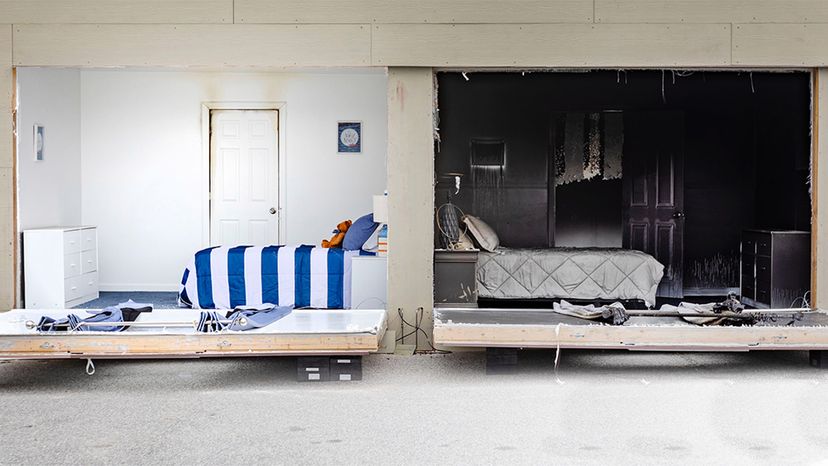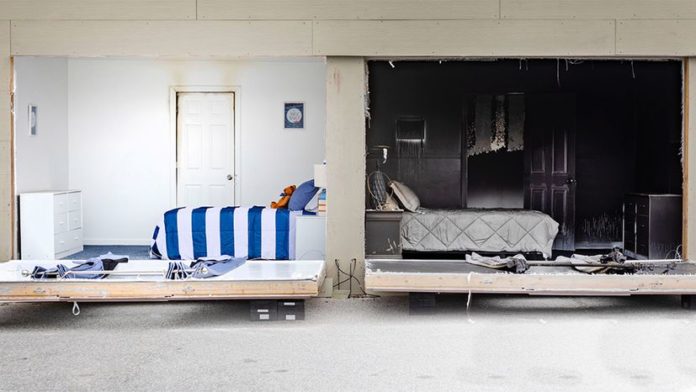 “These side-by-side bedrooms show the difference between how a room withstands a fire with the door closed (left) and the door open (right). UL Firefighter Safety Research Institute
“These side-by-side bedrooms show the difference between how a room withstands a fire with the door closed (left) and the door open (right). UL Firefighter Safety Research Institute
On a cold night in Fairfax, Virginia, firefighters were dispatched to a house fire where on arrival they were told that everyone had exited the building. The Fairfax County Fire and Rescue team went in to extinguish the fire, which was in full force with rolling flames and thick smoke. Firefighters Vincent Harrison and Kyle Ballinger entered ahead of the crew to search the home. As they were turning to finish their search, Harrison heard a voice calling for help.
They found a girl behind a closed bedroom door. The interior of the house was burnt and smoke covered, but what Harrison and Ballinger saw behind the door was a clean room.
"There was no smoke in the room, it was completely clear," Ballinger says in a video showing footage from the fire. "I noticed that there was no soot on her; she didn’t have any signs of smoke inhalation or anything like that. She was just completely clean due to the closed door."
Close Before You Doze
Most of us are familiar with fire safety tips like "stop, drop and roll" and "get low and go." But a decade of fire safety research has shown that closing doors can also have a life-saving effect, especially when getting out in case of fire is not an option.
"’Close Before You Doze’ is new to most," says Jennifer Williams, marketing specialist with UL Firefighter Safety Research Institute (UL FSRI), an organization that advances fire research knowledge and develops cutting-edge, practical fire service education. "We’re looking to create a generational behavior change of closing doors before you go to bed at night. In general, it’s not something that people think about, and they certainly don’t correlate doing it to fire safety."
Knowing that 50 percent of house fire deaths occur between 11 p.m. and 7 a.m., and because 29 percent of people surveyed did not close their bedroom doors at night, UL decided it was time to get the message across. The organization filmed a video showing how a fire moves through a home and comparing two rooms — one with the door open the other with the door closed. It demonstrated the significant beneficial effect a closed door can have during a fire. The video went viral, earning more than 9 billion (yes, billion with a b!) media impressions, according to Williams.
UL rolled out the informational campaign in 2015, initially working directly with fire services, but now it’s also communicating the message directly to the public.
How Closing Your Door Works
You might think that a closed door would be no match for a house fire. But the difference between how a room with an open door and a room with a closed door survive a fire is dramatic. Smoke moves up and out and fills a room from the top down. So it reaches the floor last, which means it can’t seep beneath the door easily. That’s why we’re taught to stay low in the case of a fire.
Firefighters have long understood the benefit of compartmentalizing a fire. Fire needs oxygen, fuel and heat to survive. Thus, if a fire can be compartmentalized, its spread will slow because it lacks oxygen. If the oxygen supply is cut off completely, the fire may even go out, Williams says.
"The more control you can have over the oxygen, the more control you can have over the fire," she explains. If you close your bedroom door at night, and a fire starts in the kitchen while you are sleeping, you may have enough time to wake up and figure out what to do. This could give you just enough time to exit the building, or to call 911. But it also might give you a safe place to wait for the fire department while the smoke, heat and toxic fumes are just beyond your door.
Also, in a bedroom with a closed door — even when a fire is raging outside — the temperature can remain below 100 degrees Fahrenheit (37 degrees Celsius) with carbon monoxide levels at 100 PPM (parts per million). Compare that to a room with the door open where temperatures can quickly rise above 1,000 degrees Fahrenheit (377 Celsius) and carbon monoxide levels become extremely toxic at 10,000 PPM.
Williams says you should actually close as many doors as you possibly can at night. One reason it’s so important is that home fires spread more quickly today than they used to. Forty years ago, we had about 17 minutes to escape a house fire, but today, that’s down to three minutes or less. We can thank contemporary building practices and synthetic materials for the change. Of course, if you can get out, get out.
Other Fire Safety Tips
So far the "Close Before You Doze" campaign is working. Williams says that 91 percent of Americans who have seen the message say they will close their bedroom doors. The remaining 9 percent say they won’t because they don’t want to be separated from children or pets.
But Williams reiterates that other fire safety measures are equally important in the home, especially working smoke alarms. She says every home should have smoke alarms on every level of the home and inside and outside of every sleeping room. Be sure they’re hardwired together so if one goes off, they all do, alerting you to a fire anywhere in the home. Ideally, you should check them every month.
You should also create a fire escape plan. It should include two ways out of every room, and a meeting place outside. And you should practice it. A surprise drill is a great way to train your children what your smoke alarms actually sound like.
Now That’s Interesting
Cooking equipment is the leading cause of home fires and fire injuries, accounting for 49 percent of home fires that resulted in 21 percent of home fire deaths.








































